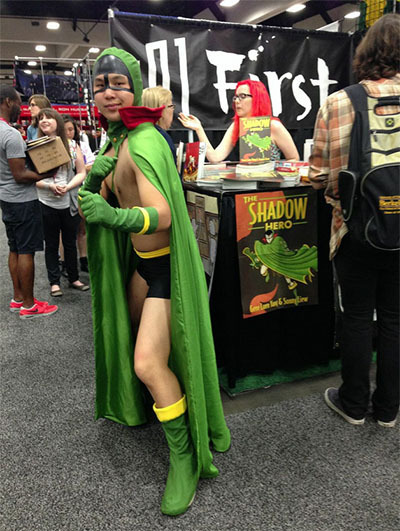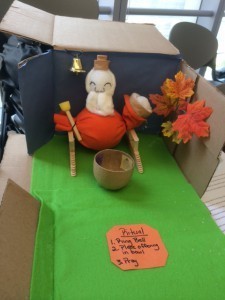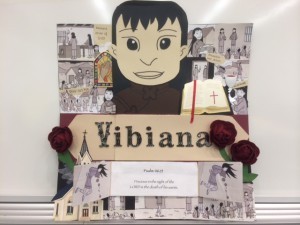Gene Luen Yang's Blog, page 8
October 9, 2014
So This Crazy Thing Happened…
This past Tuesday, I got tweets and texts from folks saying that I was on Jeopardy. Clearly they were mistaken– I am completely unqualified to be on Jeopardy unless they limited it to comics- and 80′s-cartoon-related categories. (And even then, Jesse Hamm and Jerzy Drozd would wipe the floor with me.)
Then a friend sent me a screenshot:
That’s just NUTS.
October 7, 2014
Your Email Subscription is Confirmed!

Thank you so much for joining my email list!
You’ll be receiving a welcome message soon. After that, I’ll send you updates on my upcoming graphic novels, events, and other projects. You’ll also get exclusive behind-the-scenes stuff, and opportunities to win free comic books, graphic novels, and merch.
Again, thank you. I’ll be in touch!
October 5, 2014
ICYMI: Shadow Hero Essays for Tor.com
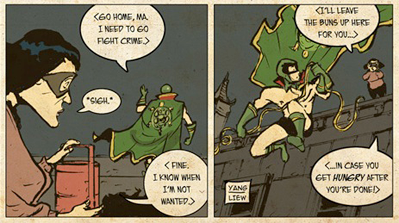
This past July, First Second Books released The Shadow Hero, a graphic novel written by me and drawn by the amazing Sonny Liew. Together, we tell the story of the (arguably) first Asian American superhero.
Lots has happened since then. The Shadow Hero stayed on the New York Times bestsellers list for a whole month! The Green Turtle, our main character, even got his own action figure from Fresh Monkey Fiction!
During the six months prior to The Shadow Hero’s debut, I wrote seven essays for Tor.com. In case you missed it, here they are:
They Came Here Not to Save Us, But to Live Among Us
On Spider-man, Puppet Monkeys, and Saturday Morning Chinese School
Parental Expectations, Practical Majors, and Advice for Making Art
Top Ten Asian Pacific American Comics Characters
October 4, 2014
Luke and Me Episode 2
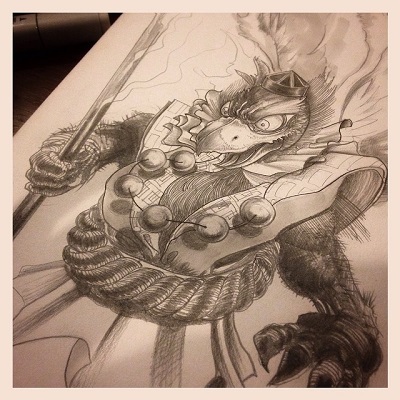
Luke’s drawing of an awesome bird demon monster guy
My friend and brother-in-law Luke is making his first comic! He asked me to help him along the process, and we’ve decided to post our interactions here.
In case you missed it, here’s how we got started:
Luke’s been at it for about a week now. Here’s our latest exchange.
***
Hi Gene,
Well, the outline isn’t quite finished yet but I’ve amassed a sizable collection of post-it notes with different ideas or plot-points on them. Obviously there are more ideas than can fit, I think, into the outline but will keep at it and hopefully have a first draft for you soon. A few questions came up during this process that I’d like to ask now.
Given that I’m far more a visual person than a literary one, I’m constantly imagining how these things will be drawn and what style of drawing will best serve the story. Throughout the years due to the different jobs I’ve taken on I’ve never fixed myself to a single style of drawing. And while my preference is for darker imagery, I am capable of drawing both pretty and cute things too. Perhaps this is too early in the process to be making any decisions but how much visualization do you do while writing the story? And how much of these early ‘visual ideas’ actually play out to the final outcome? I guess another question I have is more on the pragmatic side is whether I will be able to keep consistent the style of drawing throughout the process and do I pick a style that’s efficient to match the limited time I may have.
So I’ve attached a few examples of drawings that I’ve done recently for my kids as they are now getting into super-heroes. I do my part to share with them the characters that I grew up on both from the US and Japan. And given my time is limited with a fulltime job, wife, and a kids, I’ve started to go to bed much earlier so I can wake up at 4-5am to work on this with complete silence and focus. This gives me roughly an hour to 2-hours before the kids wake up. I’ve found that when I try to work at night I’ve got too much on my mind built up from the day and when I’m able to get up super early, it’s like I pushed the reset button on my brain and things move along much smoother.
Will be in touch soon but would love to know your thoughts on my questions as I progress on the writing portion.
Best regards,
Luke
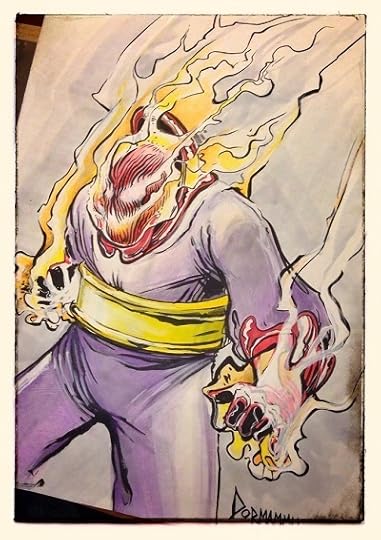
Luke’s drawing of Dormammu
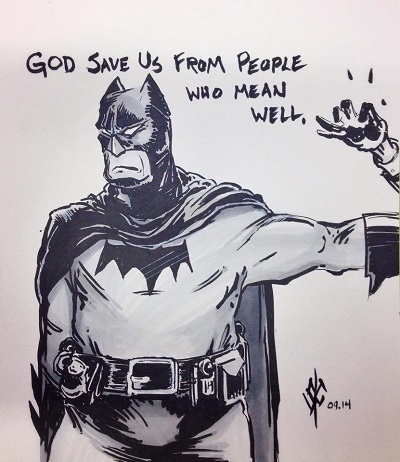
Luke’s drawing of Batman
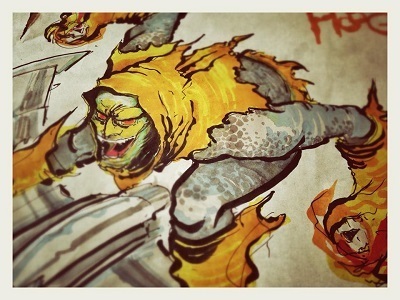
Luke’s drawing of Hobgoblin
***
Hey Luke!
Sounds like you’ve got your comics-making factory in gear! That’s awesome, but make sure the habit you’re establishing is sustainable in the long-term. Waking up at 4-5am every morning is pretty rough. Ask your wife to keep you accountable. Give yourself predetermined breaks during the week – don’t wake up that early every morning! You ever read this book called The Power of Habit by Charles Duhigg? It’s all about making new habits for yourself. One of his suggestions is to attach a reward to your new habit. For instance, if you’re trying to get yourself to workout, give yourself a smoothie after each successful workout. Your brain will start associating pleasure with the habit, making it more likely for the habit to stick.
Whatever you choose, remember that art is a long haul. Have the support in place to get you to the end.
Also, I hear you about working at night. I’m not 22 years old any more.
Now for the other stuff you asked about:
Sketches during the outlining process. Doing sketches can definitely help in the outlining process, especially for visual people. Sketches, especially sketches of entire scenes rather than individual characters, can trigger plot ideas. However, building an outline is still a words-based process. If you’re sketching, give yourself a sketching time limit. Don’t spend too much time making a detailed sketch. The bulk of your time should be spent on the words of the outline.
Here’s my cockamamie theory about all this:
Unless you’re Jason Shiga, your stories are going to be sequential. First this happens, then this happens, then this happens. Words are sequential, pictures are not. With words, your brain has to process the first word before it moves onto the next. With pictures, your brain can do a random access. It can jump from one spot to another in whichever direction it chooses.
When we make comics, we’re getting something inherently random access – pictures – to act sequential access. That’s why Jessica Abel and Matt Madden refer to making comics as “writing pictures.”
By writing an outline, you’re forcing your visual brain to think sequentially. You aren’t just hammering out the plot of your story, you’re also prepping your brain to do the hard work of breaking your story into sequential panels.
Drawing style. Given your subject matter, I think a darker tone would be appropriate. Even beyond that, though, this is your first comic. Do it in a style that’s “native” to you so you can put your energy in other places, like story structure and character design and panel composition. Give yourself home court advantage for your first game. I know you, man, and “pretty and cute” is definitely not your home court.
Consistency. This is something that I struggle with. No matter how hard I try to prevent it, my characters always change as my stories progress. This one’s nose gets a little longer, that one’s head gets a little more square. It drives me crazy, and sometimes I end up redrawing early pages to get them to match the later ones.
There are a couple of things I do to mitigate this. First, I draw model sheets for all my major characters. This is something they do in the animation industry to get all the animators to draw the same.
A model sheet is a page that shows a full body front view of a character, a full body side view, and a few of his/her most common facial expressions. Here’s one I did for Prime Baby:
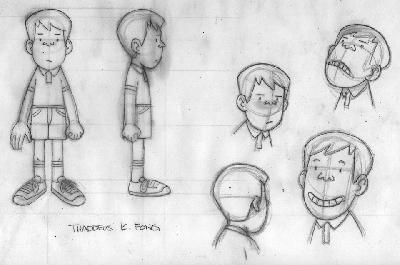
Model Sheet of Thaddeus K. Fong
I keep these taped up by my desk as I draw.
Second, when I design my characters, I think of them as the letters of an alphabet. You can tell that an A is an A and a B is a B because their designs are so distinct. You can write them kind of messy, you can write them in different fonts, and you’ll still be able to tell them apart.
I try to do the same thing with my comics’ characters. I give each a few distinguishing characteristics – a nose shape, a hairstyle, something – so that even if I’m having a bad drawing day the reader will still be able to tell my characters apart from one another.
This might be why superheroes work so well in comics. Pointy ears and a utility belt means Batman regardless of the artist’s style. Bulky and green means the Hulk. Tiara and lasso means Wonder Woman.
Osamu Tezuka is a master of this. Most of his stories are not about superheroes (as an aside, I consider the Mighty Atom a superhero) but he still applies this comic-characters-as-letters ethic to his designs. With all of his stories, you can tell who’s who even in silhouette.
All that said, consistency is still something I struggle with. With my first comic, my characters and style changed wildly from the first page to the last. I imagine the same will be true for you. This is okay, though. The primary point of this comic is your growth as a cartoonist.
Also, maybe consistency in comics is overrated. Comic books aren’t animation. Ever read The Rabbi’s Cat by Joann Sfar? That dude is proudly, purposefully inconsistent, but you never get lost. His comics are heartfelt and beautiful.
Finally, thanks for sending those drawings to liven up the posts. It’s been a while since we drew together– I’d forgotten what an amazing artist you are! Can’t wait to see your art in something sequential!
September 24, 2014
Luke and Me Episode 1
My friend Luke and I could not be more different. He’s got full sleeve tattoos. My arms are as unblemished as a newborn baby’s butt. He sports a stylish goatee. I can’t grow connectors (the hair that connects your mustache to your beard) to save my life. He’s really into Brazilian Jiu-Jitsu, and it shows in his build. I’m really into watching cartoons on Netflix, and it shows in my build.
But we do share three things in common:
We married into the same gene pool. (Our wives are sisters.)
We both love comic books.
We both have Asian fathers who disapproved of our love of comic books.
Luke and I are children of the eighties. We grew up reading the same stories – Chris Claremont and John Byrne’s X-Men, Frank Miller’s Daredevil, Todd MacFarlane’s Spider-man. We discovered the wider, more diverse world of American independent comics at around the same age. But despite being a lifelong comics fan and a fairly skilled artist, Luke hasn’t yet made a serious attempt at making a comic.
Luke’s always been a creative person. He currently runs his own line of men’s jewelry. But lately, his childhood love of comics has been calling. A story idea popped into his head and won’t leave him alone. He e-mailed me to ask what he should do next.
I love working with other comic book creators, in part because I learn so much in the process. That’s why I joined the faculty of Hamline University’s MFA Program.
Luke’s project sounded interesting. I asked him if he’d be willing to work with me in public, so other folks could see what the development of a comics creator looks like. I knew I was asking a lot. The creative process is so intensely personal. To expose it to strangers, especially when you’re just starting out, is more than intimidating.
But Luke agreed — he’s nothing if not brave. I guess all those tattoos aren’t for nothing.
So here’s how it’s going to work. Periodically, Luke is going to e-mail me his work-in-progress. I’m going to review it and give him notes, similar to what my editors do for me. I’ll also give him assignments, things that will help him get his comic done, or improve his work, or both.
Then I’ll publish our exchanges here, for you all to see. If you have anything to add, please chime in in the comments section below.
Now let’s get started! Without further ado, here’s Luke’s first e-mail to me:
***
Hey Gene,
I wanted to approach you about being a mentor to me in producing my own comic from the ground up. In my younger days I made many attempts to draw comics but without a developed storyline that resulted in mostly action sequences. Now that I’m older with wife and kids, I’d like to revisit this dream to produce something that reflects my experiences, interests and most importantly a final product that I can share with my family. I believe my drafting skills are adequate but most importantly I want to tell a good story and is why I’m approaching you about.
I have a basic idea of elements that I’d like to include but I’m not sure how to begin putting these parts together. I’d like to follow a similar story arc as Lone Wolf & Cub of revenge/redemption, but in a world of monsters/creatures. The main character is a martial arts student on the cusp of becoming a master, but is betrayed and framed for the downfall of his school. It’s on this journey for revenge that he evolves through each experience/challenge/battle that he faces.
The idea was sparked by a term coined in the Brazilian Jiu-Jitsu community, “Creonte”. It’s a name that has been adopted to represent or mean ‘traitor’ in the worst way. What I find interesting about this label is that the circumstances are not always so clear or clean as to what constitutes a creonte. The character is named this but over the course of the story, we may relook at what aspects are true about this character and how it’s not entirely black and white.
I know this is not a small request but any help would mean a great deal to me. Thanks.
Luke
***
Hey Luke,
First, this is awesome! I’m so glad you’re taking the first step in making a comic book! “Creonte” sounds like an interesting concept with rich possibilities.
But first things first. Making a comic book is a difficult, time-consuming task. It’ll take a lot out of you. I sometimes tell people that if you want to make a comic, you have to give up all your TV and half your friends. You really have to be disciplined. You have to force yourself into certain habits, because halfway through a project you’re going to feel like quitting. We all do. Habits are automatic and will get your through these times.
When Toyota designs a new car, they don’t just design the car, they also design the factory that makes the car. You have to do the same thing. You’re not just making a comic, you’re making a way of life that supports making comics. Your life is the comics-making factory. You need to come up with a writing/drawing habit and stick to it. Set aside time on a weekly or even daily basis to work on your comic. Get your family, especially your wife, to buy into it and keep you accountable. This can be an hour every evening after your kids go to sleep, an hour every other morning before you go to work, three hours two times a week, whatever works for you. And for the first year at least, you have to be a zealot about this. Eventually, your habit will become a part of you. It’ll just be the shape of your life, and even when things disrupt it, your life will return to its comics-making shape when the disruption is over.
But in the beginning, be a zealot.
Next, you need to write a plot summary (or outline) of your story. This is a description of every major incident that happens in your story. You’re not worried about pretty language or dialog here. You just want to get your ideas down and organize them into a satisfying structure.
Here’s an example. This is the plot summary I did for American Born Chinese .
.
You’ll notice, if you’ve read American Born Chinese, that the final book differs significantly from the plot summary. The plot summary ultimately will guide, but not restrict, your writing. It’s like a road map, but you’re allowed to go off-road. We’ll talk more about how to write the actual story from the plot summary when the time comes.
It’s going to take several passes to get your plot summary right, so don’t worry if you feel like flushing your first draft down the toilet when you’re finished with it. There’s a reason people sometimes call the first draft the “vomit pass.”
There are lots of ways of writing a plot summary. For you, because you mentioned that you have a bunch of elements that you want to put together. I would suggest using the Post-It method. Here’s what you do:
Write down your story beats on Post-It notes, one beat per Post-It. What’s a story beat? It’s just something that happens. It can be a verbal exchange between two characters, or a fight, or a kiss, or a discovery, or a revelation that a character has in the quiet of her head. One per Post-It. Your desk should be covered in Post-Its when you’re done. It’s okay to put every crazy thought that comes to your mind on a Post-It. Not all of them are going to make it into the plot summary.
Arrange your story beats (i.e. Post-Its) into a three act structure. What’s a three act structure? I’m going to recommend a book that I kind of hate: Blake Snyder’s Save The Cat! The Last Book on Screenwriting You’ll Ever Need
 is about screenwriting, but many of his principles can translate to comics. I’m recommending it because he gives a concise, understandable explanation of three act structure. Snyder describes the structure beneath most stories we tell in the West, whether it’s through books or comics or film. I hate Save the Cat because it’s so formulaic, so paint-by-the-numbers. If you fully embrace everything Snyder says, your stories will end up stiff and predictable and lifeless. Save the Cat is a great place to begin a conversation about story structure, but it’s not a great place to end. It is definitely NOT the last book on any kind of writing you’ll ever need.
is about screenwriting, but many of his principles can translate to comics. I’m recommending it because he gives a concise, understandable explanation of three act structure. Snyder describes the structure beneath most stories we tell in the West, whether it’s through books or comics or film. I hate Save the Cat because it’s so formulaic, so paint-by-the-numbers. If you fully embrace everything Snyder says, your stories will end up stiff and predictable and lifeless. Save the Cat is a great place to begin a conversation about story structure, but it’s not a great place to end. It is definitely NOT the last book on any kind of writing you’ll ever need.Write a plot summary based on your Post-Its.
So that’s it for now: (1) Create a habit, (2) read Save the Cat, and (3) write a first draft of a plot summary. E-mail me when you’re done and we’ll go from there!
This is gonna be awesome!
Gene
September 15, 2014
We have a Winner!
I know it’s been over a month since Comic-Con 2014, but man, I’ve been busy. Secret Coders got announced, I just finished the script for the next Avatar: The Last Airbender GN, and a new school year began!
Anyway, I finally got around to picking a winner for my Twitter contest, and it’s Deb Aoki! She found the Green Turtle on the convention floor. Here’s proof:
July 22, 2014
Find The Green Turtle at Comic-Con!
Pro cosplayer Alvin Duong has graciously agreed to help us promote The Shadow Hero by cosplaying the Green Turtle!
When I first talked to Alvin, I told him we could find a way around the Green Turtle’s bare-chestedness. Alvin wouldn’t hear of it — staying true to the source material is key for him. So here he is, embodying the Green Turtle in all his goofy Golden Age glory:
Alvin made that entire costume himself! From scratch! Impressive, isn’t it?
So the Green Turtle (i.e. Alvin) will be walking around Comic-Con — giving you the chance to win original art by me!
Here’s what you have to do:
1. Find The Green Turtle at Comic-Con 2014.
2. Take a picture of you with the Green Turtle.
3. Tweet the picture and tag me (@geneluenyang) in your tweet.
After Comic-Con is over, I’ll randomly select one of you and send you my original art!
June 2, 2014
American Born Chinese
colored by Lark Pien
published by First Second Books
recommended for High School and Up, or Middle School in Moderated Settings
I started American Born Chinese about five years into my comics career. (Though at the time, it was really more of a vocation since I wasn’t making any money at it.) I’d done a couple of stories with Asian-American protagonists, but I never dealt with the Asian-American experience head-on. Since my own ethnic heritage is such an important part of how I understand myself, I knew I wanted to. I came up with three ideas and couldn’t decide which one was the best. American Born Chinese is me doing all three at once.
May 29, 2014
Boxers & Saints
colored by Lark Pien
published by First Second Books
recommended for High School and Up
The Boxer Rebellion was fought Chinese soil over 100 years ago. Back then, the Chinese government was incredibly weak. Western powers were able to establish concessions – pieces of land that functioned as colonies – all across China. The poor, hungry, illiterate teenagers living in the Chinese countryside felt embarrassed by their nation’s weakness, so they came up with this ritual that they believed would give them mystical powers. Armed with these powers, they marched across their homeland into the major cities, killing European missionaries, merchants, soldiers, and Chinese Christians. Because their martial arts reminded the Europeans of boxing, they became known as the Boxers.
Boxers & Saints is a two-volume project. In the first volume, the Boxers are the protagonists. In second, their Chinese Christian enemies are.
I wanted each volume to be distinct from the other. Boxers is much longer, almost twice as long as Saints. It’s my attempt at a comics version of a Chinese war epic, full of glory and color and bloody battle sequences.
Saints is shorter, more intimate, more humble. The scope of the story is more limited, as is the color palette. I pulled from the aesthetics of American autobiographical comics, and I hope it reads like a personal journal.
May 28, 2014
Boxers & Saints in the Classroom Part 4
Comics educator Joan Hilty (who also happens to be one of my editors for the Avatar: The Last Airbender comics) included Boxers & Saints on her syllabus for a class titled “Violence in the Pursuit of Justice” at John Jay CUNY!
Thank you, Joan! You’re the best!
Here are some projects created by her students!


